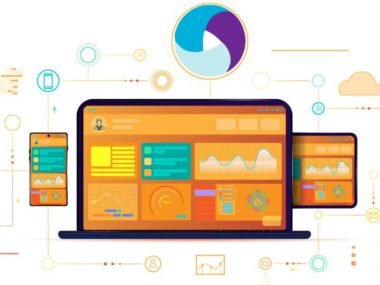Modern work is experiencing a cataclysmic shift – technology is rewriting the playbook on how we connect, create, and succeed together. As the remote workforce expands, old rules no longer apply; now, teams need fresh strategies to fuel innovation, avoid isolation, and stay on the same page. As we transition into a more digital landscape, one technology stands out as the connective tissue holding global businesses together: video conferencing. What if I told you remote teams can actually outdo their in-office counterparts in terms of collaboration, engagement, and creativity? Video conferencing is making that a reality, one virtual meeting at a time.
The transition to remote work was a paradigm shift that many predicted, but few were prepared for. As organisations moved their operations online, the need for effective communication channels became paramount. Video conferencing emerged not just as a tool but as a foundation for this new era of remote collaboration, offering a semblance of the in-person interaction that teams were suddenly missing. It’s not just about seeing each other’s faces; it’s about recreating the dynamics of teamwork and the nuances of communication that are lost when working remotely. Take, for instance, the magical combo of instantaneous communication and teams that feel genuinely connected – this technology makes it all happen seamlessly.
Accelerating tech innovation, deep-seated changes in our collective work psyche, and crisis-mandated business agility have all collided to catapult remote work into the mainstream. Video conferencing has become the unsung hero, stepping in to keep teams connected and workflows humming despite the uncertainty surrounding us. The ability to connect visually, share ideas in real-time, and foster a sense of normalcy amid change has made video conferencing an integral part of the remote work infrastructure.
The Shift from Traditional Office Setups to Digital Platforms for Teamwork and Meetings
The transition from physical offices to digital workspaces is one of the most significant changes in the modern work environment. We’ve said goodbye to huddled conference rooms and hello to the age of virtual meetings, where everyone can weigh in from the comfort of their own screens. Gone are the days of tedious travel for meetings; now, people can tap into digital platforms and sync up via video conferencing, guaranteeing that distance is no obstacle to collaboration and progress.
1. The Goal is Smooth and Efficient Communication that Happens in the Moment
Communication is the oxygen that fuels successful teamwork, and when that teamwork happens across distances, it’s only instantaneous chatter that keeps everyone synced. Video conferencing facilitates this by allowing team members to convey messages, interpret reactions, and adjust their communication in real-time, much like they would in a physical meeting room. Team cohesion and lucid ideas rely on immediate feedback – without it, innovative flows and collective vibes dry up fast.
Compared to asynchronous communication methods, such as email or chat, which can delay feedback and obscure tone, video conferencing offers a much-needed immediacy and clarity. Face-to-face conversation used to be the norm; now, live interactions bring back that same unbridled flow. Misconceptions get lost in the mix, and fruitful discussions ensue.
2. High-Performing Teams are Built on Trust and Open Communication
Nothing brings a team together like a face-to-face conversation. Video conferencing bridges the distance, simulating an in-person meeting that’s both comfortable and effective. Between physical and virtual spaces, there’s an invisible gap. Right facial expressions, subtle gestures, and revealing reactions help you surmount this hurdle, connecting naturally, even when apart. When team members physically connect, mutual understanding takes a quantum leap forward, as their collective capacity for collaboration, creativity, and problem-solving sharpens significantly.
3. Supporting Scalable Team Collaboration
As businesses grow and projects expand, the need for a communication tool that can scale with the organisation becomes critical. With video conferencing solutions, it doesn’t matter if you’ve got a tight-knit team of five or a massive workforce of thousands – what matters is that everyone stays connected and on the same page. One major perk of scalable collaboration is that startups can bypass the treadmill of constant platform updates and infrastructure revamps, focusing instead on their rapid growth and development, just like the big players.
For instance, many video conferencing platforms offer tiered services, allowing companies to start with basic functionalities and add more users, features, or higher-quality video as their needs expand. When companies expand or reorganise, clear communication is make-or-break. And that’s only possible with channels that can flex and grow alongside the team – whether that’s a dozen people or a few thousand.
4. Breaking Down Geographical Barriers
One of the most transformative impacts of video conferencing is its ability to make distance irrelevant. Teams spread across different cities, countries, or even continents can collaborate as effectively as if they were in the same room. Companies that operate on a global scale can mine the best talent from every continent, fold diverse expertise into a single unit, and harmonise their efforts across multiple time zones to maintain a 24/7 operational pace.
Thanks to video conferencing, companies can now rope in team members from all corners of the globe, collaborating in ways previously unimaginable. For instance, a tech startup based in San Francisco can seamlessly collaborate with its developers in Bangalore and its marketing team in London, creating a continuous workflow that leverages the unique advantages of its global positioning.
5. Integrating with Collaboration Tools
Video conferencing doesn’t exist in isolation. Two plus two equals four, but when you pair this solution with other digital powerhouses, that’s when the magic really happens. Imagine your digital workflow as a complex puzzle; video conferencing provides the missing piece, binding project management, file sharing, and collaborative editing into a beautifully functional whole.
Team members can ditch the hassle of juggling multiple platforms by sharing screens, collaboratively editing documents, and exchanging files in real-time during video calls – boosting productivity along the way. With these integrations, transitions become butter-smooth, and communication consolidates into one spot, making it a breeze to keep tabs on discussions, decisions, and what needs to get done.
6. Flexible Work Environments are the Answer to Keeping Teams Engaged and Productive
With remote work on the rise, people are expecting a lot more flexibility from their jobs these days. Collaborative work styles just got a whole lot easier with video conferencing, which lets teams connect instantly, no matter where individual members happen to be. With the freedom to create a schedule that aligns with their lifestyle, individuals can stop playing catch-up and start living in sync, where family dinners, morning yoga, and deadlines all coexist peacefully.
Hybrid work models, where employees split their time between the office and remote locations, are particularly reliant on video conferencing to maintain consistency in communication and collaboration. Whether you’re Working from home or desk-bound, feeling connected to your colleagues is essential; it’s what transforms a disparate group into a powerful, collaborative unit.
7. Improving Meeting Efficiency
Meetings are infamous for being time-consuming and often unproductive, but video conferencing can change that narrative. With features like agenda setting, screen sharing, and the ability to record sessions for later review, video conferences can be more structured and focused than traditional meetings. People are naturally more focused and concise when they’re being recorded, which makes for meetings that are both efficient and productive.
Moreover, video conferencing platforms often include tools for polling and Q&A, enabling real-time feedback and making it easier to gauge consensus or address concerns promptly. Meetings get a major productivity boost when everyone can contribute, no matter where they’re sitting.
8. Reducing Travel Time and Costs
Before the advent of effective video conferencing, in-person meetings often required significant travel, resulting in not only lost time but also substantial expenses. Imagine meeting with clients and colleagues from the comfort of your own office – video conferencing makes it happen, eliminating the need for pricey plane tickets and weeks spent on the road.
Fewer miles travelled translates to a cleaner, healthier planet – a tradeoff we can all get behind. Imagine a future where businesses aren’t coughing up quite so much carbon; it’s achievable when they cut back on air travel and road trips, aligning their actions with a greener agenda.
9. Video Conference API: Customization for Business Needs
As businesses seek to provide a seamless communication experience tailored to their specific needs, many turn to Application Programming Interfaces (APIs) for video conferencing solutions. Imagine having the power to revolutionise your company’s communication style – video conference API by iotum lets you do just that, either by crafting bespoke video conferencing applications or augmenting your current software with seamless video integration.
Customization can be as subtle as incorporating your company’s logo and colour scheme, or as extensive as crafting specialised features that address specific pain points or business objectives. For instance, a telehealth service can incorporate video conferencing into its patient management system, enabling secure and private consultations with healthcare professionals.
10. A Productive Workforce Requires Intentional Training and Development Strategies
The boundaries of traditional training environments are blurred when video conferencing is thrown into the mix, allowing professionals to upskill from anywhere. With remote training, companies can assemble a diverse group of participants from around the world, all sharing the same educational experience, and putting an end to training inconsistencies. With video conferencing, a veteran employee’s decades of experience can be condensed into bite-sized chunks, arming newcomers with the insights they need to hit the ground running and thrive in their roles.
Screen sharing and virtual whiteboards transform video conferencing into dynamic hotbeds of engagement, where ideas flow freely and students soak up knowledge. For instances that demand hands-on practice, like software walkthroughs or medical simulations, physical presence is no longer a necessity.
11. Businesses Can Provide the Level of Service by Tackling Communication Barriers
The rise of video conferencing has transformed the way businesses engage with customers, permitting them to readily apologise for mistakes, celebrate milestones, and share warm smiles – the sorts of human touches that breed loyalty. Support teams can use video calls to resolve complex issues more effectively, showing instead of just telling. Trust grows when every interaction feels personalised and meaningful; that’s the magic of this enhanced customer experience.
Additionally, with video conferencing, customer service can transcend language barriers through real-time translation features and other accessibility tools, ensuring clear communication with a diverse customer base. What if digital interactions didn’t feel so… digital? By incorporating visual elements, businesses can create experiences that mirror the warmth and personality of human connections.
Conclusion
One thing’s for sure – our digital landscape is shifting fast, and the future of work is going to be all about virtual connections. Imagine platforms that practically read your mind, slash bureaucratic tasks, and unravel the mysteries of human communication – that’s where AI and machine learning are headed.
Take the awkwardness out of virtual meetings by adding VR and AR to the mix, and you might just forget you’re not in the same room as your colleagues – that’s how transformative this tech could be. We’re witnessing a cultural shift: the norms of traditional workplaces are dissolving, replaced by virtual gathering spaces that boldly recast the way we interact, sparks flying as humans come together to share, debate, and imagine the next big thing.
No longer just an auxiliary tool, video conferencing now lies at the core of business strategy, allowing companies to tap into a global talent pool, shrink distances, and make big ideas happen. Picture this: a global village where distance is a distant memory, and video conferencing is the pulse that keeps us connected, whether we’re working, learning, or just catching up.










